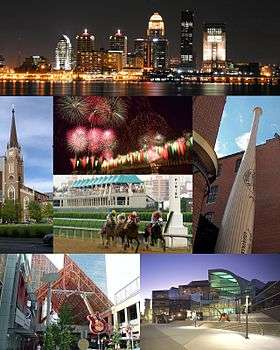Transit Authority of River City
 | |
|
TARC 2013 Gillig BRT | |
| Founded | 1974 |
|---|---|
| Locale | Louisville, Kentucky, United States |
| Service area | Louisville Metro |
| Service type | Bus service |
| Routes | 40 |
| Fleet | 225 |
| Fuel type | ULSD |
| Website |
www |
The Transit Authority of River City (TARC) is the major public transportation provider for the Louisville, Kentucky, United States metro area, which includes parts of Southern Indiana. This includes the Kentucky suburbs of Oldham County, Bullitt County, Clark County, and Floyd County in southern Indiana. TARC is publicly funded and absorbed various earlier private mass transit companies in Louisville, the largest of which was the Louisville Transit Company.
TARC operates a fleet of 225 accessible buses, including numerous hybrids. Starting in 2004, TARC purchased hybrids, and by 2008 started purchasing clean diesel buses for a cleaner, greener fleet. By late Winter 2013, TARC added 16 more clean diesels. Then, by mid-Summer 2013, 11 hybrids were added, bringing TARC's hybrid total to 32. By Fall 2013, TARC added 21 clean diesel commuter buses, then as of Fall 2014 TARC added 12 more clean diesels; some of them are WiFi-enabled and have comfortable seating. TARC has recently put 12 additional updated buses on the road with 13 more due to arrive by late 2016. This brings their clean diesel total to 82 when the other 13 arrive. There will be 96. All-electric buses have been circulating downtown Louisville since early 2015, and eight more will be hitting the road on one local route serving the Iroquois neighborhood, and Iroquois Park. These buses will not be fare-free, will have a 42-passenger capacity, and will share the 8th Street charging station with one of the trolley routes. according to The Courier-Journal. There are also two charging stations in downtown Louisville, one at 3rd and York, the other at 8th and Market. These buses will have a 30-passenger seating capacity, and be able to operate for up to two hours on a single charge. These buses, like the old trolleys, will be fare-free.
TARC provides service 365 days a year. It also operates many specialized routes providing transportation to major local employers, educational institutions and recreational events. It began bus operations in 1974. TARC has explored other forms of public transit, including light rail, but as of 2009 provides only bus service.
History
The transit authority was created in 1971 after 1970 legislation authorized city and county governments to operate mass-transit systems using local funding. At the time, public transit was still being provided in Louisville by the private Louisville Transit Company. The Louisville Transit Company had long operated mass transit lines in Louisville, converted from electric trolleys to diesel buses in the late 1940s, and changing its name from the Louisville Railway Company in 1947.[1]
| Ridership by year. Includes TARC's predecessor, Louisville Transit Company, in years prior to 1974. |
|---|
|
1920 – 84 million |
Following a trend seen in cities across America, the company had seen annual ridership decline from 84 million in 1920 to 14 million in 1970. The ridership was no longer enough for to cover operating expenses and in 1971 it posted its first-ever loss. In 1972 the company announced it would cease operations on September 1, 1974.[1]
The local government began subsidizing fares in July 1973, but this was not enough to make Louisville Transit Company profitable. At about the same time, Bridge Transit Co., which provided mass transit between Louisville and Jeffersonville, ceased operations due to lack of revenue, clearly setting the stage for a metropolitan area without any private mass transit companies.[1]
In 1974, voters approved a controversial referendum allowing for an increased occupational tax to fund mass transit, which was pushed for by then-mayor Harvey Sloane.[2] Combined with a federal grant, this was enough for TARC to purchase the Louisville Transit Company, buy new buses, reduce fares, and extend new service lines.[1] TARC bought up the remaining mass transit companies in the area; Blue Motor Coach Lines, which served outlying areas, in 1976 and the Daisy Line, connecting New Albany and Louisville, in 1983.[1]
In 1993, TARC experimented with a "water taxi" service connecting the Belle of Louisville wharf and Towboat Annie's Restaurant in Jeffersonville.[3] During the 1990s and early 2000s, TARC advocated extensive funding to build and operate light rail system in the Louisville area, but despite wide press coverage, the plans never went past planning stages.
In February 1994, an audit committee headed by future political candidate Bruce Lunsford revealed TARC had been mismanaging funds and was on pace to deplete its once-large trust fund due to skyrocketting expenses such as door-to-door services for the disabled as well as rates of spending on personal services and fringe benefits for administrators that was much higher than in transit companies for similar sized cities.[4] In the fallout of the audit, TARC's executive director resigned and fares were nearly doubled before year's end.[5]
In August 2011, TARC's new $4.5 million, 17,700 square-foot, Maintenance and Training building received Gold LEED (Leadership in Energy and Environmental Design) Certification.[6]
Administration

TARC purchased Louisville's Union Station for $2 million in 1977, the year after the former train station had ceased rail operations. The trainyard was replaced with a large maintenance facility for TARC buses and the former train station is now TARC's administrative headquarters.[1] In 2003, TARC did a major remodeling of Union Station for the first time since it purchased the facility. The renovation cost $2.1 million.[7]
TARC is administered by an eight-member board. TARC had a budget of $67.8 million for the 2008–09 fiscal year. Fares only cover about 12% of TARC's operating expenses; the rest is paid for by Jefferson County's occupational tax, federal aid and some other minor sources. [8] The occupational tax is 0.20%, it makes up about two-thirds of TARC's operating expenses in any given year. The actual total varies due to availability of federal grants and fares collected.[9] In 2002, TARC had 710 employees, 460 of whom were bus drivers.[10]
Some funding comes from a transportation trust fund kept by TARC. In 1992, the fund contained $28 million, which a local alderman claimed made TARC the "Cadillac" of America's bus systems, and unsuccessfully proposed raiding it to fund the Louisville Free Public Library.[11] The fund declined from $34 million in 1989 to $13 million in 1994, prompting severe cutbacks and rate hikes that year.[12]
Fleet
As of 2014, TARC has a fleet of 225 buses. 32 are hybrid buses, which combine a traditional diesel engine and an electric motor to reduce emissions and eliminate tailpipe exhaust during acceleration, but cost nearly twice as much as a conventional bus. The hybrids were provided through Federal highway bill earmarks by U.S. Senator Jim Bunning. In 2007, a new TARC bus cost $285,000, while a hybrid bus cost $504,000. Now a New clean diesel costs $405,000 dollars a bus while a hybrid costs $600,000 dollars a bus.
In October 2010, TARC announced that the hybrid bus fleet would grow to 21, with the addition of 9 new buses, with a grant of $3.9 million, from the Federal Transit Authority's Clean Fuels Bus and Bus Facilities Program. A previous grant through the federal stimulus program paid for nine hybrid buses that arrived in July 2010.[13]
All buses are equipped with "kneeling" bus technology that makes them easier to board, and a wheelchair lift. TARC once required disabled riders to use a special service with smaller buses that had to be scheduled in advance, but all regular buses were made accessible following protests in 1986.[14]
Current bus fleet
| Year | Manufacturer | Model | Fleet Numbers | Engine & Transmission | Fuel Type | Notes | Image |
|---|---|---|---|---|---|---|---|
| 1998 | Gillig | phantom Advantage Low Floor | 901-999 |
|
Diesel | Some retired 922/971 scrapped/sold due to fire damage | |
| 2000 | Gillig | phantom Advantage Low Floor 29 and 40 foot | 2001-2057 | Some 29-foot units stored out of service
Allison Transmission B400R-5 Speed Automatic |
Diesel | ||
| 2001 | Gillig | Advantage Low Floor 40 foot | 2101-2111 |
Allison Transmission B400R-5 Speed Automatic |
Diesel | 2105 scrapped/sold due to fire damage | |
| 2002 | Gillig | Advantage Low Floor 29 foot | 2250-2266 |
Allison Transmission B400R-5 Speed Automatic |
Diesel | ||
| 2003 | Gillig | Advantage Low Floor 40 foot | 2301-2320 |
Allison Transmission B400R-5 Speed Automatic |
Diesel | ||
| 2004 | Gillig | Advantage Low Floor | 2401-2405 |
|
Diesel-Electric | ||
| 2005 | Gillig | Advantage Low Floor 40 foot | 2501-2516 |
Allison Transmission B400R-5 Speed Automatic |
Diesel | ||
| 2007 | Gillig | Advantage Low Floor 40 foot hybrid | 2701-2704 |
|
Diesel-electric | ||
| 2008 | Gillig | Advantage Low Floor | 2801-2806 |
Allison Transmission B400R-5 Speed Automatic |
Diesel | ||
| 2009 | Gillig | Advantage Low Floor 40 foot hybrid | 2901-2903 |
|
Diesel-Electric | ||
| 2009 | Gillig | Advantage Low Floor | 2910-2926 |
Allison Transmission B400R-5 Speed Automatic |
Diesel | 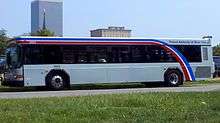 Gillig 2923 | |
| 2010 | Gillig | Advantage Low Floor | 1001-1009 |
|
Diesel-Electric |  Gillig 1009 | |
| 2013 | Gillig | Advantage Low Floor | 1301-1316 |
Allison Transmission B400R-6 Speed Automatic |
Diesel | 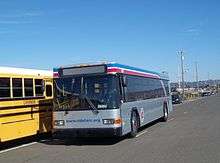 Gillig 1309 | |
| 2013 | Gillig | Advantage Low Floor | 1320-1330 |
|
Diesel-Electric | 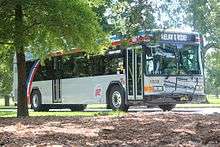 Gillig 1328 | |
| 2013 | Gillig | BRT | 1350-1370 |
Allison Transmission B400R-6 Speed Automatic |
Diesel | 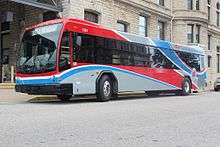 Gillig Brt 1351 | |
| 2014 | Gillig | Advantage Low Floor | 1401-1412 |
Allison Transmission B400R-6 Speed Automatic |
Diesel | ||
| 2016 | Gillig advantage LF 1601-1612 13 more to arrive by end of year | Allison B-400R 6 speed automatic transmission | 8 electric buses to hit the road this summer |
Services

TARC operates a series of city buses that serve throughout the Louisville area. TARC claims over 7,000 bus stops, although only about 200 of them have benches and rain shelters—the rest simply have a sign indicating the location is a bus stop.[15] The stops are served by 32 weekday and weekend routes, 12 express routes with weekday service only, totalling 44 routes. The daily routes are named for the primary road they serve. On the daily routes, there is no more than hour between scheduled buses at any stop, and on weekdays on the busiest routes have even less time between stops. Most of the daily routes have existed under the same name and number for decades, although their routes have almost all been extended to provide access to suburban locations.[16]
TARC operates various circulators providing access to hospitals, Downtown Louisville and art galleries. Since 1999, TARC has operated a shuttle service for the University of Louisville's main campus. It operates two routes shuttling workers to Worldport, the hub of United Parcel Service and one of Louisville's largest employers.[17] In 2007, TARC launched a program called "Ride to Safety" which allows domestic abuse victims to board TARC buses to be given transportation to a shelter.[18]
They also operate a system of diesel-powered rubber-tired buses designed in the style of early 20th century streetcars that act as circulators in the downtown hotel and shopping districts and on certain days are used to provide special shuttle services in other shopping and entertainment areas. The tourist trolleys began operation in November 1987 and their role and fare has varied over the years as funding has allowed.[19] By the end of 2014, 10 new all-electric buses will be in operation. The first of 10 has arrived already, and is slated to begin testing soon.
TARC and its predecessor provided shuttle access to the Kentucky Derby and Kentucky Oaks since the 1950s, but in 2008 new federal rules required the racetrack, Churchill Downs, to negotiate with private companies to provide service. The shuttle operation transported tens of thousands of people each year and provided TARC with over $200,000 of annual revenue.[20] TARC provides service to some other local events, including Thunder over Louisville and the Kentucky State Fair.[21]
Through a program called "Bikes on Board", TARC has bike racks installed on the front of all its full-size buses, each with the capacity to hold two bicycles. The program began in 2001, and by 2004 all buses were equipped. In 2005, TARC reported an average of 6,000 riders a month used the bike racks.[22]
Fares
The standard fare became $1 in 1994, up from $0.85 for peak hours and $0.50 for off-peak hours. On July 1, 2007, it was raised to $1.25. In June 2008 the adult fare was raised to $1.50 to help defray the increased cost of fuel. Since July 1, 2012, the adult fare has been $1.75.[23] Since Spring 2015, fareboxes were updated. The amount for a one-way adult fare was unchanged. Smartcards will be accepted for payment, with the fare discounted to $1.50, while those without smartcards will have to provide exact change.[24] Discounts are offered to senior citizens and high school students.[23] A "day tripper" one-day pass can be purchased for $3.50 while boarding the bus[23] (TARC3 is currently not participating but will be phased in at a later time).[24] Express fares are $2.75, or $1 with a bus pass currently.[23] Children under 6 with a fare-paying rider pay no fare, limited to 3.
See also
References
- 1 2 3 4 5 6 Kleber, John E., ed. (2002). The Encyclopedia of Louisville. University Press of Kentucky. p. 892.
- ↑ Ryan, Ed (November 6, 1974). "Transit referendum". The Courier-Journal.
- ↑ Staff writer (May 6, 1993). "Maiden voyages of TARC water taxi draw 4,500". pp. 3B.
- ↑ Walfoort, Nina (February 5, 1994). "TARC audit assails budget, management". The Courier-Journal. pp. 1A.
- ↑ Walfoort, Nina (February 11, 1994). "Arnett resigns: TARC's financial priorities redirected". The Courier-Journal. pp. 1B.
- ↑ TARC's Maintenance and Training Annex receives Gold Certification
- ↑ Shafer, Sheldon (September 6, 2003). "Time-worn Union Station gets a face-lift". The Courier-Journal. pp. 1B.
- ↑ Shafer, Sheldon (June 3, 2008). "Rising fuel bill may push TARC fares up 25 cents". The Courier-Journal.
- ↑ Shafer, Sheldon (August 4, 2008). "TARC jumps on fuel deal". The Courier-Journal. p. 1B.
- ↑ Green, Marcus (November 14, 2002). "TARC will get award for workplace fitness". pp. 1F.
- ↑ O'Doherty, Mary (June 23, 1992). "Bather would raid TARC to aid library". The Courier-Journal. pp. 1A.
- ↑ Walfoort, Nina. "TARC begins push for another round of fare increases". The Courier-Journal. pp. 1B.
- ↑ "Hybrid Bus fleet grows to 29". Bizjournals.com. October 28, 2010. Retrieved January 27, 2011.
- ↑ Jessie, Lisa (July 23, 1988). "7 disabled people held after protest of bus line". The Courier-Journal. pp. 7A.
- ↑ Shafer, Sheldon (January 1, 2006). "TARC seeks state funds to build shelters". The Courier-Journal. pp. 1B.
- ↑ Shafer, Sheldon (August 21, 2008). "Gas prices get people on board with TARC". The Courier-Journal. p. 1A.
- ↑ "TARC - Route listing". Transit Authority of River City. Retrieved June 6, 2008.
- ↑ Gerth, Joseph (December 27, 2006). "Buses will help take abuse victims to safety". The Courier-Journal. pp. 1B.
- ↑ Shafer, Sheldon (August 9, 1988). "Free trolley rides expected through '88". The Courier-Journal. pp. 2B.
- ↑ Shafer, Sheldon (March 27, 2008). "Rule change gives others shot at Derby bus runs". The Courier-Journal. pp. 1A.
- ↑ Halladay, Jessie (April 9, 2008). "Surviving Thunder's roads". The Courier-Journal. pp. 1B.
- ↑ Bruggers, James (January 18, 2005). "More bikers hitching a ride on TARC". The Courier-Journal. pp. 1A.
- 1 2 3 4 "Fares and Online Purchasing". TARC. Retrieved October 4, 2014.
- 1 2 "New Fare Collection System". TARC. Retrieved October 4, 2014.
External links
- Official TARC Website
- TARC Awarded $4.4 Million Federal Grant for All-Electric Buses—Louisville.gov September 19, 2012
- TARC Awarded $9 million in federal grants—Business First October 28, 2010
- TARC Bike Rack Rap on YouTube
- 1961 system map
